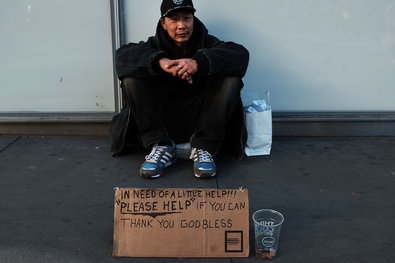
How to Help the Homeless in New York and Other High-Cost Cities
Even as rates of homelessness decline nationally, the number of homeless continues to rise in many cities with high-cost housing markets, like New York City. While the cost of living in these cities has skyrocketed, wages remain stagnant for many low- and middle-income residents — so much so that half of New York City residents say they can barely make ends meet. How can cities with high-cost housing markets, like New York, better serve the homeless?
* rise = 오르다, 올라가다/ housing market 주택 시장/ cost of living = 생활비, 생계비/ skyrocket = 급등하다/ stagnant = 침체된; 고여 있는/ resident = 거주자[주민]/ so much so that ~ = 매우 그러하므로 ~하다/ barely = 간신히, 가까스로, 빠듯하게/ make ends meet = 겨우 먹고 살 만큼 벌다
 주택 시장의 비용이 높은 뉴욕같은 도시는 어떻게 노숙자들에게 더 도움이 될 수 있나요?
주택 시장의 비용이 높은 뉴욕같은 도시는 어떻게 노숙자들에게 더 도움이 될 수 있나요?
1. We Know What Works, Now We Need More Funding
Many low-income New Yorkers are a victim of the city’s newfound success. They need access to affordable, or supportive, housing.
2. Ease Regulation to Free Up Affordable Housing
As more units come on the market, upward pressure on market-rent costs would ebb, and supply would be adjusted to demand.
3. Prevent Families From Being Driven Out of Their Homes
We can't build our way out of the crisis. Low-income renters need legal and social help in the face of abusive landlords and illegal rent hikes.
4. Medicaid Can Provide Funding for Support Services
It's a win-win: Government funds are freed up to be invested in housing and Medicaid saves money on acute and inpatient care of the homeless.
5. Support Community Land Trusts for Affordable Housing
Large-scale solutions have to provide permanent stability for at-risk residents, as well as respect for the autonomy of individuals and communities.
Sample Essay
We Know What Helps the Homeless. Now We Need More Funding
Walking the streets of New York in 2015, it’s impossible to ignore the jarring contrasts. Look up, and cranes, from record construction activity, fill the sky. Look down, and the city’s homeless problem seems worse than ever before.
New York City has added half a million jobs over the last five years, but over the same period the number of homeless New Yorkers grew by 20,000 – more than 50 percent.
Part of the increase stems from the Bloomberg administration’s stubborn refusal to offer housing to those in shelter.
But another part is surely this: Many low-income New Yorkers are a victim of the city’s newfound success.
With wages at the bottom stagnant, rents soaring and gentrification spreading across formerly affordable neighborhoods, even a full-time job is no guarantee against becoming homeless. For the 2015 fiscal year, nearly 30,000 families applied for shelter in New York City – down from a height of almost 40,000 during the recession, but still a staggering 10,000 families more than before the recession began, according to data we received from the Department of Homeless Services after a FOIA request.
But if the causes of modern, mass homelessness are complex, fortunately the remedies are relatively simple. We know what works: Now, we just need investments in the solutions at a larger and more sustained scale.
For the vast majority of families seeking shelter, the issue is affordability. For these victims of "crisis homelessness," the de Blasio administration is beginning to offer an array of locally funded rental assistance vouchers. It has also given homeless families with vulnerable children access to precious New York City Housing Authority apartments. Increasing that access and committing a full 10 percent of his affordable housing plan to move homeless families out of costly shelters will accelerate his nascent efforts, and turn the tide of misery for many.
While homeless families suffer largely out of sight, it’s homeless single adults — particularly those with severe and persistent mental illness — who haunt our streets, parks and subways. For the "chronically homeless," supportive housing, which combines stable housing with mental health and other services, is most effective at helping them regain the stability needed to turn their lives around. It’s also far cheaper for taxpayers than the jails, hospitals and shelters where these vulnerable New Yorkers would end up otherwise. Mayor Bill de Blasio boldly embraced this cornerstone of decency, when he announced last month that the city would make an unprecedented investment to fund the creation of 15,000 units of supportive housing over 15 years.
The good news is: This year, New York City’s shelter population has shrunk for the first time in nearly a decade. Without the mayor’s efforts, the crisis we face today would be far worse. But the city cannot fully solve the problem on its own.
Historically, the state has joined in full partnership, matching the city in funds for supportive housing creation. Unfortunately, Gov. Andrew Cuomo has proposed funding for only 3,700 units of supportive housing for New York City over the next seven years.
The sheer scale of the catastrophe playing out on our streets demands a sustained solution. Governor Cuomo's offer is not going to cut it.





![]() 주택 시장의 비용이 높은 뉴욕같은 도시는 어떻게 노숙자들에게 더 도움이 될 수 있나요?
주택 시장의 비용이 높은 뉴욕같은 도시는 어떻게 노숙자들에게 더 도움이 될 수 있나요?






